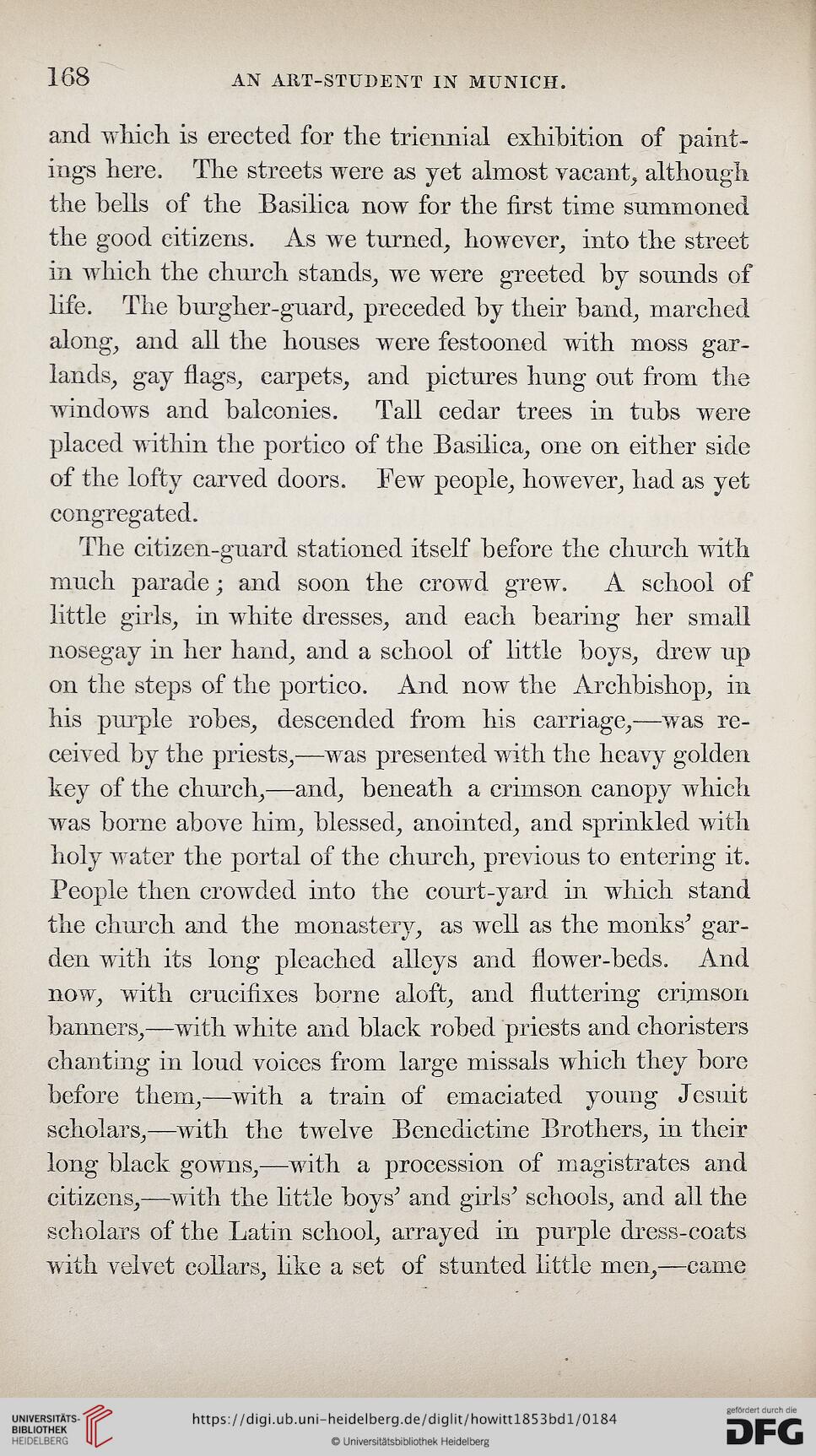168
AN ART-STUDENT IN MUNICH.
and which is erected for the triennial exhibition of paint-
ings here. The streets were as yet almost vacant, although
the bells of the Basilica now for the first time summoned
the good citizens. As we turned, however, into the street
in which the church stands, we were greeted by sounds of
life. The burgher-guard, preceded by their band, marched
along, and all the houses were festooned with moss gar-
lands, gay flags, carpets, and pictures hung out from the
windows and balconies. Tall cedar trees in tubs were
placed within the portico of the Basilica, one on either side
of the lofty carved doors, hew people, however, had as yet
congregated.
The citizen-guard stationed itself before the church with
much parade; and soon the crowd grew. A school of
little girls, in white dresses, and each bearing her small
nosegay in her hand, and a school of little boys, drew up
on the steps of the portico. And now the Archbishop, in
his purple robes, descended from his carriage,-—was re-
ceived by the priests,—was presented with the heavy golden
key of the church,—and, beneath a crimson canopy which
was borne above him, blessed, anointed, and sprinkled with
holy water the portal of the church, previous to entering it.
People then crowded into the court-yard in which stand
the church and the monastery, as well as the monks’ gar-
den with its long pleached alleys and flower-beds. And
now, with crucifixes borne aloft, and fluttering crimson
banners,—with white and black robed priests and choristers
chanting in loud voices from large missals which they bore
before them,—with a train of emaciated young Jesuit
scholars,—with the twelve Benedictine Brothers, in their
long black gowns,—with a procession of magistrates and
citizens,—with the little boys’’ and girls’ schools, and all the
scholars of the Latin school, arrayed in purple dress-coats
with velvet collars, like a set of stunted little men,—came
AN ART-STUDENT IN MUNICH.
and which is erected for the triennial exhibition of paint-
ings here. The streets were as yet almost vacant, although
the bells of the Basilica now for the first time summoned
the good citizens. As we turned, however, into the street
in which the church stands, we were greeted by sounds of
life. The burgher-guard, preceded by their band, marched
along, and all the houses were festooned with moss gar-
lands, gay flags, carpets, and pictures hung out from the
windows and balconies. Tall cedar trees in tubs were
placed within the portico of the Basilica, one on either side
of the lofty carved doors, hew people, however, had as yet
congregated.
The citizen-guard stationed itself before the church with
much parade; and soon the crowd grew. A school of
little girls, in white dresses, and each bearing her small
nosegay in her hand, and a school of little boys, drew up
on the steps of the portico. And now the Archbishop, in
his purple robes, descended from his carriage,-—was re-
ceived by the priests,—was presented with the heavy golden
key of the church,—and, beneath a crimson canopy which
was borne above him, blessed, anointed, and sprinkled with
holy water the portal of the church, previous to entering it.
People then crowded into the court-yard in which stand
the church and the monastery, as well as the monks’ gar-
den with its long pleached alleys and flower-beds. And
now, with crucifixes borne aloft, and fluttering crimson
banners,—with white and black robed priests and choristers
chanting in loud voices from large missals which they bore
before them,—with a train of emaciated young Jesuit
scholars,—with the twelve Benedictine Brothers, in their
long black gowns,—with a procession of magistrates and
citizens,—with the little boys’’ and girls’ schools, and all the
scholars of the Latin school, arrayed in purple dress-coats
with velvet collars, like a set of stunted little men,—came




